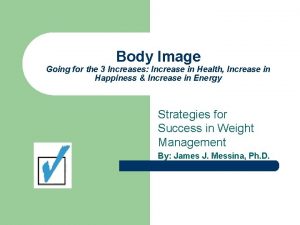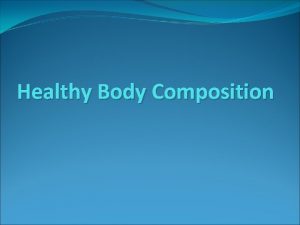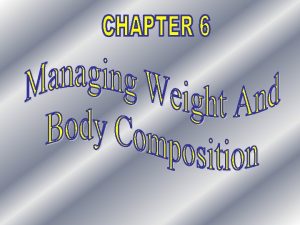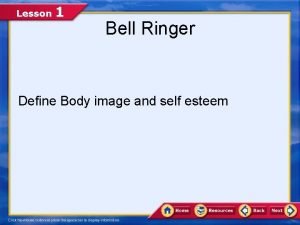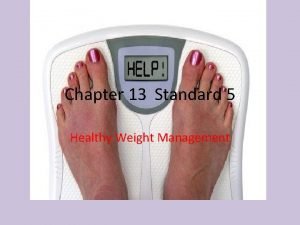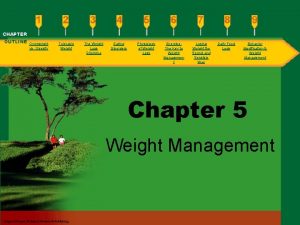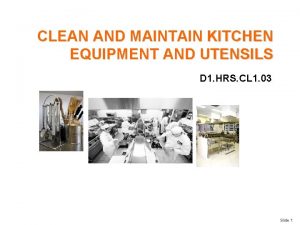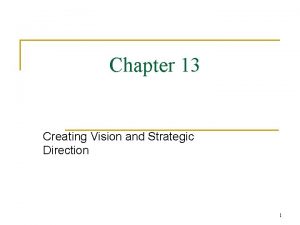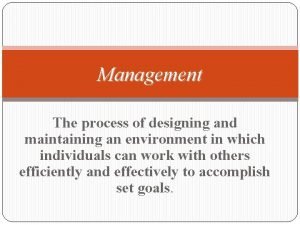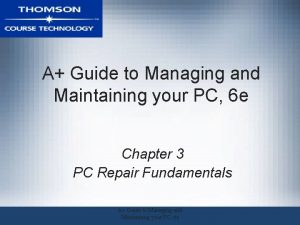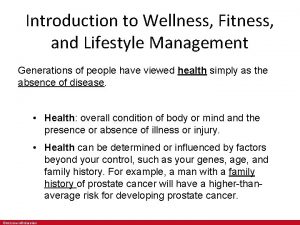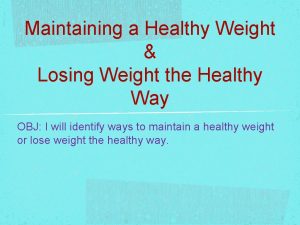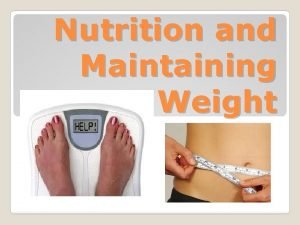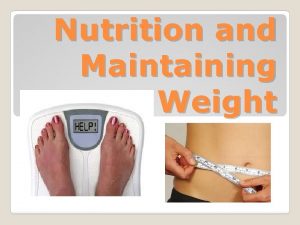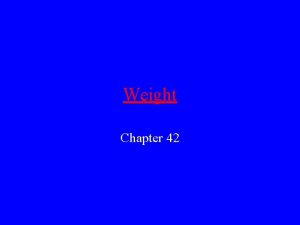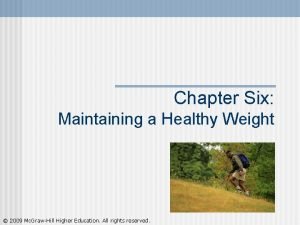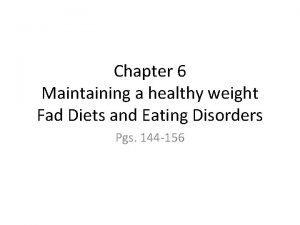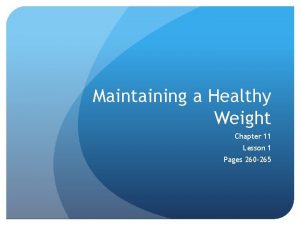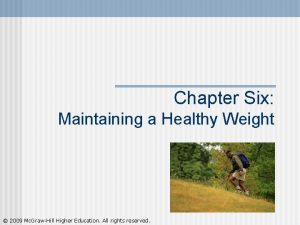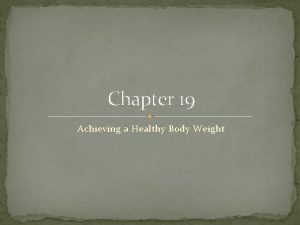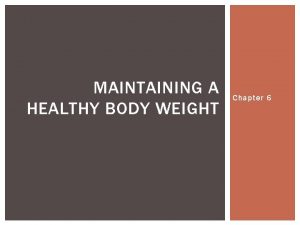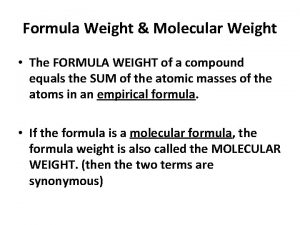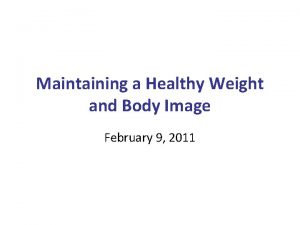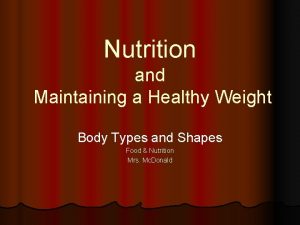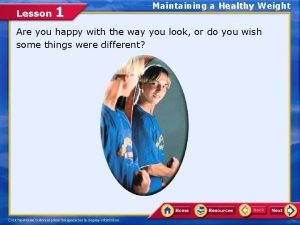Chapter 6 Reaching and Maintaining a Healthy Weight




































- Slides: 36

Chapter 6: Reaching and Maintaining a Healthy Weight

Objectives: • Describe the current epidemic of overweight/obesity in the United States and globally • Understand the health risks associated with Obesity • Identify factors that put people at risk for overweight and obesity • distinguishing between controllable and uncontrollable factors

Objectives, con’t • Learn reliable options for determining your percentage of body fat and a healthy weight. • Explain the effectiveness, potential pros/ cons of various weight control strategies • Exercise, Diet • Lifestyle modification • Supplements/diet drugs • Surgery

Factors Contributing to Overweight and Obesity • Obesogenic: Describes environments that promote increased food intake, unhealthy foods, and physical inactivity; it refers to conditions that lead people to become excessively fat. • More than 71 percent of U. S. adults (38% obese and 33% overweight) are considered overweight or obese. • Overweight refers to having a body mass index (BMI) of 25. 0 to 29. 9; obesity refers to a BMI of 30. 0 or higher.

Obesity in the United States

Genetic and Physiological Factors • Several factors appear to influence why one person becomes obese and another remains thin, including: • Sensitivity to satiety, or feeling full. • Body type and genes • “Thrifty gene” theory • Metabolic rates • Hormonal influence: ghrelin and leptin • Fat cells and predisposition to fatness

One Person at Various Stages of Weight Loss • Based on the Hyperplasia Theory

Environmental Factors • Technology • Advertising • Convenience • Profits

Early Sabotage: A Youthful Start on Obesity • Today’s youth: eat larger portions and, from their earliest years, exercise less than any previous generation • Studies suggest that maternal undernutrition, obesity, and diabetes during gestation and lactation are also strong predictors of obesity in children

Potential Negative Health Effects of Overweight and Obesity

Psychosocial and Economic Factors • Eating tends to be a focal point of people’s lives • social ritual associated with companionship, celebration, and enjoyment. • Socioeconomic factors provide obstacles or aids to weight control • Money, where you live, and how well educated you are

Lifestyle Factors • Overweight and obesity are largely due to the way we live. • Data from the National Health Interview Survey: • 41 percent of adults age 18 and over in the United States met the guidelines for aerobic activity • Only 20. 8 percent met the minimum guidelines for both aerobic exercise and muscle strengthening.

Assessing Body Weight and Body Composition • Some fat is essential for healthy body functioning. • Essential fat is the fat necessary for the maintenance of life and reproductive functions. • Fat regulates body temperature, cushions and insulates organs and tissues, and is the body’s main source of stored energy. • Storage fat, the nonessential fat that many of us try to shed, makes up the remainder of our fat reserves.

Overweight and Obesity • Overweight - body weight more than 10 percent above healthy recommended levels: in an adult, a BMI of 25 to 29. • Obesity - body weight that is more than 20 percent above healthy recommended levels; in an adult, a BMI of 30 or more equals obesity. • Morbid obesity - body weight 100 percent or more above healthy recommended levels; in an adult, a BMI of 40 or more equals morbid obesity.

Underweight • Underweight - body weight more than 10 percent below healthy recommended levels; in an adult, a BMI below 18. 5 equals underweight. • Men: body fat that is only 3 to 7 percent of total body weight • Women: body fat that is 8 to 15 percent of total body weight. • Extremely low body fat causes hair loss, visual disturbances, skin problems, and other issues.

Body Mass Index • Body mass index (BMI) is a number calculated from a person’s weight and height that is used to assess risk for possible present or future health problems. • BMI = weight (kg)/height squared (m 2) • People with healthy weights are those with BMIs of 18. 5 to 25. • Problems associated with BMI?


Waist Circumference and Ratio Measurements • Useful tool in assessing abdominal fat, which is considered more threatening to health than fat in other regions of the body. • A waistline of greater than 40 inches for men and 35 inches for women may be indicative of greater health risk. • Waist-to-hip ratio measures regional fat distribution. A ratio of greater than 1 in men and 0. 8 in women indicates increased health risk.

Measures of Body Fat • • • Look in the mirror! Underwater (hydrostatic) weighing Skin folds Bioelectric impedance analysis (BIA) Dual-energy X-ray absorptiometry (DXA) Bod Pod

Overview of Various Body Composition Assessment Methods Hydrostatic (Underwater)Weighing

Skinfold Calipers • Involves “pinching” a person’s fold of skin at numerous locations of the body • Folds are measured with a caliper • Can estimate body fat with an error of 3 -4%

Bioelectrical Impedance Analysis (BIA) • Painless electrical current, instrument measures resistance • Lean mass has more water – current passes through easily • Muscle hold more water (greater conductivity) • More fat, higher resistance • Calculates body water, fat-free mass and body fat%

Understanding Calories and Energy Balance • Calorie - unit of measure that indicates the amount of energy gained from food or expended through activity. • Each time a person consumes 3, 500 extra calories, it results in one pound of additional storage fat. • Conversely, each time your body expends 3, 500 extra calories, it results in one pound less of body fat.

Managing Your Weight • Failure in weight loss is related to thinking about losing weight in terms of short-term dieting rather than long-term lifestyle changes in eating behavior. • Bouts of restrictive dieting may be physiologically harmful. • Many still regain any weight that they may have lost. • Maintaining a healthful body takes constant attention and nurturing over the course of one’s whole life

Avoid Trigger-Happy Eating

Improving Your Eating Habits • Keep a daily log of your eating patterns. • Look for clues in your environment or emotions that may cause you to want food. • Stress can increase or decrease appetite. • Once you have evaluated your behaviors and know your triggers, you can devise a plan for improving your eating habits.



Why Should You Care?

See It! Video: Experiment Shows Portion Control Is Key to Weight Loss

Including Exercise • Increasing BMR, RMR, or EMR levels will help burn calories. • Basal Metabolic Rate • Resting Metabolic Rate • Exercise Metabolic Rate • Using large muscle groups improves energy expenditure. • The number of calories spent depends on: • The number and proportion of muscles used • The amount of weight moved • The length of time the activity takes

The Concept of Energy Balance

Keeping Weight Control in Perspective • Weight loss is difficult for many people. • People of the same age, sex, height, and weight may have differences of as much as 1, 000 calories a day in RMR. • It is unrealistic and potentially dangerous to punish your body by trying to lose weight in a short period of time. • It is better to try to lose 1 to 2 pounds of weight during the first week and stay with a slow, easy regimen.

Considering Drastic Weight-Loss Measures • Miracle diets, fasting, starvation, and other very-low-calorie diets (VLCDs) • Serious health risks and should always be followed only under medical supervision. • Low-calorie intake forces the body to convert fat into energy, a process called “ketosis”. • Drug treatment, though potentially helpful, can result in health risks over time. • Surgery may be the only option for some, but it is • Associated with health risks and potentially serious side effects.

Weight-Loss Surgery Alters the Normal Anatomy of the Stomach

Trying to Gain Weight • Determine possible cause: • Athletes or extreme athletes may burn more calories tha they consume • Stressed and skip meals • Loss of taste smell due to age • Difficulty preparing meals • Examine behaviors and consider options to improve dietar habits and needs
 An extreme harmful eating behavior
An extreme harmful eating behavior Maintaining a healthy body composition and body image
Maintaining a healthy body composition and body image Maintaining a healthy body composition and body image
Maintaining a healthy body composition and body image Restoring lost body fluids
Restoring lost body fluids Maintaining a healthy body composition and body image
Maintaining a healthy body composition and body image Chapter 13 healthy weight management answers
Chapter 13 healthy weight management answers Chapter 11 keeping a healthy weight study guide answers
Chapter 11 keeping a healthy weight study guide answers Is steel production bulk gaining or reducing
Is steel production bulk gaining or reducing Nutrition and productivity
Nutrition and productivity Healthy soil healthy life poster ideas
Healthy soil healthy life poster ideas Healthy community poster
Healthy community poster Healthy nurse healthy nation
Healthy nurse healthy nation Pictures of a billion dollars
Pictures of a billion dollars Chapter 17 drivers ed
Chapter 17 drivers ed Tolerable weight is a body weight
Tolerable weight is a body weight Chapter 22 reaching out cross-cultural interactions
Chapter 22 reaching out cross-cultural interactions Chapter 22 reaching out cross-cultural interactions
Chapter 22 reaching out cross-cultural interactions Chapter 22 reaching out cross-cultural interactions
Chapter 22 reaching out cross-cultural interactions Chapter 15:9 maintaining transmission based precautions
Chapter 15:9 maintaining transmission based precautions Role of nurse in maintenance of records and reports
Role of nurse in maintenance of records and reports The process of designing and maintaining an environment
The process of designing and maintaining an environment Building and maintaining a website
Building and maintaining a website Clean and maintain kitchen tools equipment and premises
Clean and maintain kitchen tools equipment and premises Curving traffic pattern
Curving traffic pattern Elements of retail image
Elements of retail image Vision focuses on the current reality and maintaining it
Vision focuses on the current reality and maintaining it Purchasing and maintaining a computer
Purchasing and maintaining a computer The process of designing and maintaining an environment
The process of designing and maintaining an environment Building and maintaining customer relationships
Building and maintaining customer relationships Guide to managing and maintaining your pc
Guide to managing and maintaining your pc Guide to managing and maintaining your pc
Guide to managing and maintaining your pc Guide to managing and maintaining your pc
Guide to managing and maintaining your pc Bonnie tyler reaching for the infinite heart
Bonnie tyler reaching for the infinite heart Introduction to wellness and fitness
Introduction to wellness and fitness Strategies for reaching global markets
Strategies for reaching global markets Hinduism method of reaching paradise
Hinduism method of reaching paradise Reaching out from within
Reaching out from within

